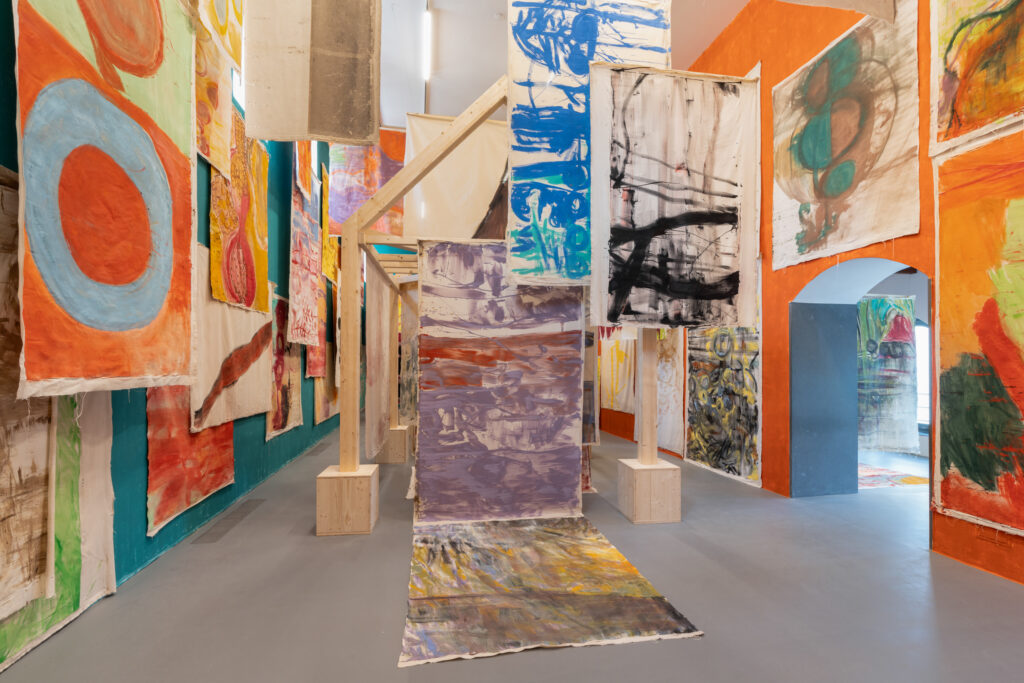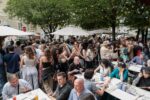Vivian Suter / Elene Chantladze

Mostra doppia personale.
Comunicato stampa
kaufmann repetto is pleased to announce Vivian Suter’s exhibition Tintin Nina Disco, including more than fifty large scale works resulting from the artist’s decades-long research immersed in the lush Guatemalan rainforest. This series of canvases epitomizes Suter’s creative alliance with the vicissitudes of terrain and weather, introducing us to the incessant rhapsody of nature and its deep connection with the artist’s practice. This resonates also in the fluid, non-hierarchical presentation of the works, often overlapping, suspended and swaying in the space, absorbed in the ecosystem and spirit of the artist’s surroundings.
Vivian Suter was born in Buenos Aires, Argentina, in 1949, from Austrian migrants. When the government threatened to take over their business in the sixties, the family moved to Basel, Switzerland, where Vivian Suter studied before departing on a long series of journeys through Europe, Africa, the Middle East and Asia. During her travels she made collages, drawings, sculptures and took photographs along the way, and since her early works, one could notice how rooted the idea of pilgrimage, movement and change was in her practice. As soon as her career began to take off she moved once again, far from the spotlight of the European art scene.
Vivian Suter has been living in a house she built on a former coffee plantation, near the lake on the slopes of Panajachel, Guatemala, since the eighties. Her art, which has always breathed and embodied the contexts in which she worked, was formed as an act of mapping, marking and naming her surroundings. The tropical rainforest is, in fact, an active character in the plethora of conditions that contribute to the genesis of the artwork. The canvases carry traces of their environment: rain water and mud stains, scratches from the tree branches, and even some paw prints of Tintin, Nina or Disco, the beloved dogs that roam in Suter’s open air studio.
The rich colors that are abstractly painted on the canvases recall pristine water bodies, butterfly patterns, foggy sunlight. Vivian Suter’s pictorial intervention always reveals a beautiful collaboration with the context she lives in, and her artworks aim to transform the environment of every exhibition space they inhabit. The surface of the painting serves as a testimony for nature’s morphing – the canvas is a precarious living material, and, other than representing nature, the artist witnesses its gradual decay and its vibrant regeneration. This approach towards the materiality of the unframed canvas imposes a shift in appreciation for the object’s preciousness.
Adam Szymczyk, who included Suter in both his Athens and Kassel setting for documenta 14, writes about the artist’s radical perspective in his essay Against the Evil Eye:
“Thus, nature – itself the lure for and source of colonialism, its raw material extracted by both the culture and industry of colonizers – serves as a respectful, protective cover that prevents looting and looking and alleviates the effects of the “evil eye” elsewhere called the colonial gaze.”¹
It seems like whenever Suter’s works are shown in an exhibition space, the circular process of the painting’s coming into being briefly interrupts, conceding a moment gratitude and awe for nature’s unstoppable, never-ending flow, as the object’s final purpose is to be swallowed back into the elements that made it.
¹Adam Szymczyk, Against the Evil Eye: Vivian Suter’s Intrepid Painting in Vivian Suter, The Power Plant Toronto, Hatje Cantz Verlag, Berlin, 2019
The gale is raging over the river
Like a beast
A fondling weeping willow
Slips away from the levee, with murmur
Cloaks in its lap
A startled carp
Tiny fingerlings
As disassembled rafts
Waves carry forth
An ensemble of leaves
A cunning jackal mimics
The screeching of the wind
The jackal and the wind are polyphony-howling till dawn
Weeping-haired and warring willow twigs
In solitude, protect still
The tiny fingerlings –
Forsaken, lone
poem by Elene Chantladze
translated by Ana Gzirishvili
from Elene Chantladze, Simon Lässig, Stories for children, 2023
Elene Chantladze has spent a lifetime telling stories, keeping diaries, imagining theatrical plays, composing poems and, maybe most importantly, painting. Her exhibitions at kaufmann repetto Milan and New York present a selection of works that encapsulate the variety and versatility of Elene Chantladze’s poetic.
Among the roughly mixed acrylic and watercolors, occasional splashes of gasoline, strokes of mulberry fruit and traces of a ballpoint pen, are layered over crumpled paper, unevenly cut pages from an outdated calendar, rocks found on the shores of the Black Sea, disposable plastic plates with leftover cake stains from her grandchildren’s birthday party.
The materials Chantladze uses derive from her immediate environment, much like the folkloristic, familiar subjects of her paintings. She usually starts by painting the background densely, and often proceeds to populate the landscape before the pigments finish to dry. Some might compare her practice to the imagination that children have when outlining creatures in the cloudy sky, a sense of wonder and creativity one often loses during adulthood. So a yellow stain on a messy green background becomes a duck with the simple addition of a dark orange dot for its beak, and a constellation of colorful dabs becomes a bouquet of flowers, enormous compared to the pale female figure beside it.
Elene Chantladze’s art is ultimately a reflection of her existence, the dreamy atmosphere and fable-like scenarios in her paintings adopt a powerful, relatable language. Her work is not formally defined by her approach to the medium, but depicted through a naive poetic surrealism, an invitation to rediscover the world through the eyes of an outsider, far from the influence of major cities and art centers.
Elene Chantladze was born in Supsa, Georgia, in 1946. She lives and works in Tskaltubo, Georgia. Her works have recently seen a rise in popularity, being displayed in solo exhibitions at M HKA Antwerp and Kunsthalle Zurich (2023).



